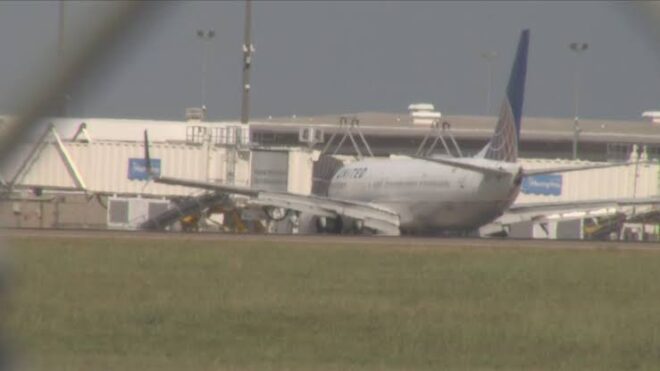
United Airlines flight UA1196 experienced a turbulent encounter on its journey from Cancun, Mexico, to Chicago, Illinois. The aircraft, a Boeing 737-900ER registered as N66814, encountered a sudden bout of severe turbulence over Memphis, Tennessee. This incident, which occurred on Wednesday afternoon, necessitated an emergency landing at Memphis International Airport. The turbulence caused significant concern among passengers and crew, resulting in seven reported injuries.
The flight in question is a regular scheduled service operated by United Airlines between Cancun and Chicago. Flight UA1196 departed from Cancun at 12:15 p.m. local time, initially proceeding without incident. However, while approaching the Memphis area, the aircraft was subjected to a rapid onset of severe turbulence that prompted an immediate descent. The crew declared an emergency and diverted to Memphis, where the Boeing 737-900ER landed safely at 2:45 p.m. local time.
The aircraft involved, N66814, is a Boeing 737-900ER that has been part of United Airlines’ fleet since February 2014. With a service age of approximately 10.6 years, this aircraft is one of 136 Boeing 737-900ERs operated by the airline. Of these, 123 are in active service, with an average fleet age of 11.7 years. The Boeing 737-900ER forms an essential part of United’s mainline fleet, which includes a variety of aircraft types, such as Airbus A319s, A320s, and Boeing 737 MAX models.
Reports indicate that the turbulence was sudden and intense, causing the aircraft to descend quickly. Passengers described the incident as a “violent jolt,” and there were moments of panic as the plane dropped altitude. The unexpected turbulence was severe enough to prompt the pilots to divert the flight to Memphis International Airport for an emergency landing. The decision was made to ensure the safety and well-being of those onboard, particularly in light of reports of injuries.
Following the emergency landing, United Airlines confirmed that seven people were injured due to the turbulence. Six individuals declined medical treatment, while one person was taken to a local hospital for further evaluation. The airline expressed gratitude to the flight crew for their prompt response and efforts to manage the situation, emphasizing that safety remains the highest priority.
United Airlines issued a statement acknowledging the severe turbulence encountered on flight UA1196 and commended the crew for their professionalism during the event. “Flight UA1196 encountered a brief period of severe turbulence Wednesday afternoon,” the statement read. “We’re grateful to our crew for their efforts to ensure the safety of our employees and customers.” The airline is cooperating with relevant authorities to investigate the incident, including the Federal Aviation Administration (FAA), which will review the circumstances surrounding the turbulence event.
In the aftermath of the incident, N66814 was inspected for any potential damage before being repositioned to Chicago. The aircraft later resumed its scheduled operations, and at the time of reporting, it was en route to LaGuardia Airport in New York.
Severe turbulence is defined as violent, erratic air movement that causes large, abrupt changes in altitude or attitude of the aircraft. Such turbulence can occur unexpectedly, even in clear skies, as a result of atmospheric disturbances like wind shear, thunderstorms, or jet streams. The severity of turbulence events can vary, with the most extreme cases posing risks to passenger safety and requiring immediate corrective action by the flight crew.
In-flight turbulence is a leading cause of injuries to airline passengers and crew. When an aircraft encounters severe turbulence, individuals who are not wearing seat belts are at a heightened risk of being thrown about, which can lead to injuries. The incident on flight UA1196 underscores the importance of adhering to safety protocols, such as keeping seat belts fastened whenever seated.
Recent years have seen an increase in turbulence-related incidents, attributed in part to changes in atmospheric conditions brought about by climate change. The phenomenon known as “clear-air turbulence” has become more common, and experts suggest that global warming is making the atmosphere more unstable, thus leading to more frequent turbulence events. United Airlines, like other major carriers, implements advanced forecasting and real-time monitoring systems to detect areas of turbulence and adjust flight paths accordingly. Nonetheless, turbulence remains an inherent risk in air travel.
United Airlines operates an extensive mainline fleet consisting of a variety of aircraft models. In addition to the Boeing 737-900ER, the airline’s fleet includes 81 Airbus A319s, 84 A320s, 15 A321s, 40 Boeing 737-700s, 141 737-800s, 12 737-900s, 101 737 MAX 8s, 80 737 MAX 9s, 61 Boeing 757s, 53 Boeing 767s, 96 Boeing 777s, and 71 Boeing 787s. Safety remains a top priority for the airline, with rigorous maintenance schedules and advanced training programs for flight crews to handle emergencies, including turbulence.
The decision to land at Memphis following the turbulence event exemplifies the airline’s commitment to safety. Pilots are trained to assess weather conditions continuously and make precautionary landings when required to protect passengers and crew.
Investigations into the turbulence encounter on flight UA1196 will involve reviewing weather data, radar information, and the aircraft’s flight path to understand what caused the sudden turbulence. The FAA will work closely with United Airlines to determine any contributing factors and recommend steps to mitigate future risks. For the affected passengers and crew, the airline is likely providing support and offering compensation for the disruption and any medical costs.
As the aviation industry continues to adapt to evolving atmospheric patterns, turbulence management remains a critical aspect of airline operations. This incident serves as a reminder of the unpredictable nature of air travel and the ongoing need for vigilance in ensuring passenger safety.